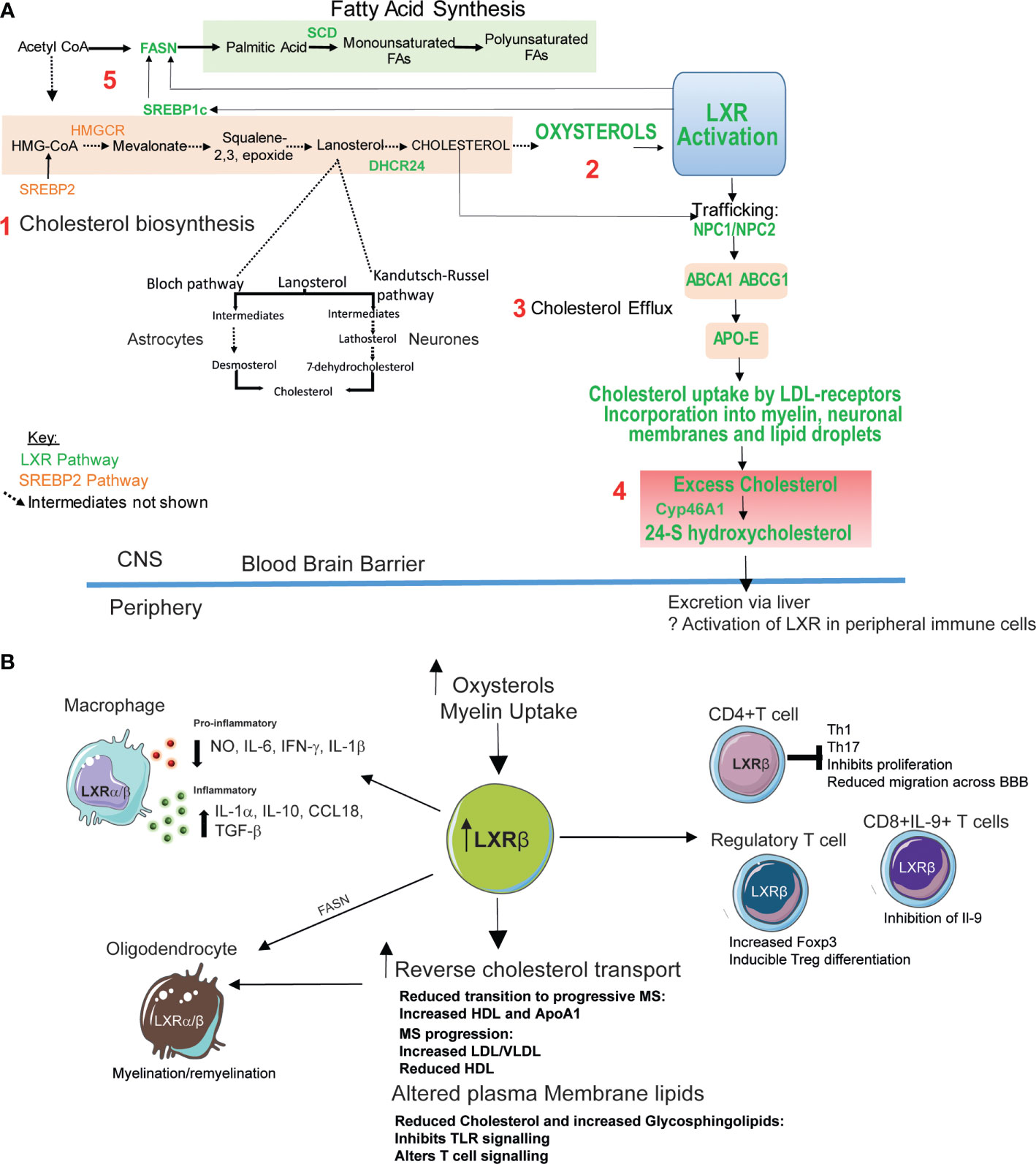Lipid Metabolism in Multiple Sclerosis
Multiple Sclerosis (MS) is a chronic, debilitating neurological disorder characterized by the immune-mediated attack on the central nervous system (CNS), leading to demyelination and neurodegeneration. The intricate interplay between lipid metabolism and immune regulation has garnered significant interest in understanding MS pathogenesis and exploring potential therapeutic avenues. This blog post delves into the role of lipid metabolism in MS, emphasizing the impact of genetic markers and recent advancements in therapeutic strategies.
The Role of Lipid Metabolism in MS

Mechanisms of Liver X Receptor (LXR) activation in Multiple Sclerosis (MS) and its impact on lipid metabolism and immune cell function. LXR activation influences cholesterol biosynthesis, efflux, and fatty acid synthesis, which play critical roles in remyelination and inflammation control in MS. (Pineda-Torra, I., et. al. (2021))
Lipid metabolism plays a pivotal role in maintaining cellular function and homeostasis, particularly within the CNS. Cholesterol, oxysterols, and sphingolipids are key components involved in the formation and maintenance of myelin sheaths, which insulate neuronal axons. Disruption in lipid metabolic pathways can lead to impaired remyelination and exacerbate neurodegenerative processes observed in MS.
Genetic Markers Influencing Lipid Metabolism in MS
Genetic variations significantly influence lipid metabolism, contributing to MS susceptibility and progression. Liver X Receptors (LXRs), encoded by the NR1H3 and NR1H2 genes, are nuclear transcription factors that regulate cholesterol homeostasis and immune responses. LXRs are activated by oxysterols, derivatives of cholesterol metabolism, and play a crucial role in modulating lipid transport and inflammatory processes.
Studies have identified polymorphisms in genes encoding LXRs and other lipid-regulating proteins as potential risk factors for MS. For instance, variations in the NR1H3 gene have been associated with altered LXR function, impacting cholesterol efflux and immune cell regulation. Additionally, polymorphisms in the genes encoding ATP-binding cassette transporters (ABCA1 and ABCG1), which are LXR target genes, have been linked to MS susceptibility due to their role in cholesterol transport and homeostasis.
Lipid Biomarkers in MS
Cholesterol and its derivatives serve as important biomarkers for MS progression and disease activity. Elevated levels of low-density lipoprotein (LDL) cholesterol and apolipoprotein B (Apo-B) have been correlated with increased disability scores and the formation of new lesions in MS patients. Conversely, high-density lipoprotein (HDL) cholesterol has been shown to have protective effects, reducing blood-brain barrier (BBB) injury and inflammatory infiltrate.
Oxysterols, particularly 24S-hydroxycholesterol, are metabolites of cholesterol that cross the BBB and serve as indicators of brain cholesterol metabolism. Higher levels of 24S-hydroxycholesterol have been observed in early stages of MS, reflecting active neurodegeneration. However, in advanced stages, reduced levels of this oxysterol suggest extensive neuronal loss and brain atrophy.
Therapeutic Potential of Targeting Lipid Metabolism
Given the central role of lipid metabolism in MS, therapeutic strategies targeting these pathways hold promise. LXRs, due to their regulatory functions in cholesterol homeostasis and immune modulation, have emerged as attractive targets. Activation of LXRs has been shown to promote remyelination, reduce inflammation, and modulate immune cell differentiation, thereby ameliorating MS symptoms in experimental models.
Synthetic LXR agonists, such as T0901317 and GW3965, have demonstrated efficacy in reducing CNS inflammation and enhancing remyelination in preclinical studies. However, their clinical translation has been challenging due to adverse effects like hepatic steatosis and hypertriglyceridemia. Newer generations of LXR agonists aim to selectively target specific tissues or immune cells, minimizing systemic side effects while maximizing therapeutic benefits.
Novel Therapeutic Approaches and Future Directions
Recent advancements in nanoparticle-based delivery systems offer innovative solutions for targeting LXRs and other lipid metabolic pathways in MS. Nanoparticles encapsulating LXR ligands can efficiently deliver these compounds to specific tissues, enhancing their therapeutic efficacy while reducing off-target effects. Additionally, tissue-specific delivery strategies, such as macrophage-targeting nanoparticles, have shown promise in modulating inflammation and promoting tissue repair in MS.
Furthermore, exploring the interplay between lipid metabolism and other signaling pathways may unveil new therapeutic targets. For instance, the integration of lipid metabolic pathways with nuclear receptors like peroxisome proliferator-activated receptors (PPARs) offers a broader understanding of immune regulation and metabolic control in MS.
Conclusion
Lipid metabolism plays a crucial role in the pathogenesis and progression of MS, with genetic variations and metabolic disruptions contributing to disease susceptibility and severity. Targeting lipid metabolic pathways, particularly through the activation of LXRs, presents a promising therapeutic strategy for MS. Continued research into genetic markers, lipid biomarkers, and innovative delivery systems will enhance our understanding and treatment of this complex disease, paving the way for improved outcomes for MS patients.
References:
Pineda-Torra, I., Siddique, S., Waddington, K.E., Farrell, R., & Jury, E.C. (2021). Disrupted Lipid Metabolism in Multiple Sclerosis: A Role for Liver X Receptors? Frontiers in Endocrinology, 12:639757. doi: 10.3389/fendo.2021.639757.
Zhornitsky, S., McKay, K.A., Metz, L.M., Teunissen, C.E., & Rangachari, M. (2016). Cholesterol and markers of cholesterol turnover in multiple sclerosis: relationship with disease outcomes. Mult Scler Relat Disord, 5:53-65. doi: 10.1016/j.msard.2015.10.005.
Fellows Maxwell, K., Bhattacharya, S., Bodziak, M.L., Jakimovski, D., Hagemeier, J., & Browne, R.W. (2019). Oxysterols and apolipoproteins in multiple sclerosis: a 5 year follow-up study. J Lipid Res, 60(7):1190-8. doi: 10.1194/jlr.M089664.
Tettey, P., Simpson, S., Taylor, B., Blizzard, L., Ponsonby, A.L., Dwyer, T., et al. (2014). An adverse lipid profile is associated with disability and progression in disability, in people with MS. Mult Scler J, 20(13):1737-44. doi: 10.1177/1352458514533162.
Meffre, D., Shackleford, G.G., Hichor, M., Gorgievski, V., Tzavara, E.T., & Trousson, A. (2015). Liver X receptors alpha and beta promote myelination and remyelination in the cerebellum. Proc Natl Acad Sci, 112(24):7587-92. doi: 10.1073/pnas.1424951112.

